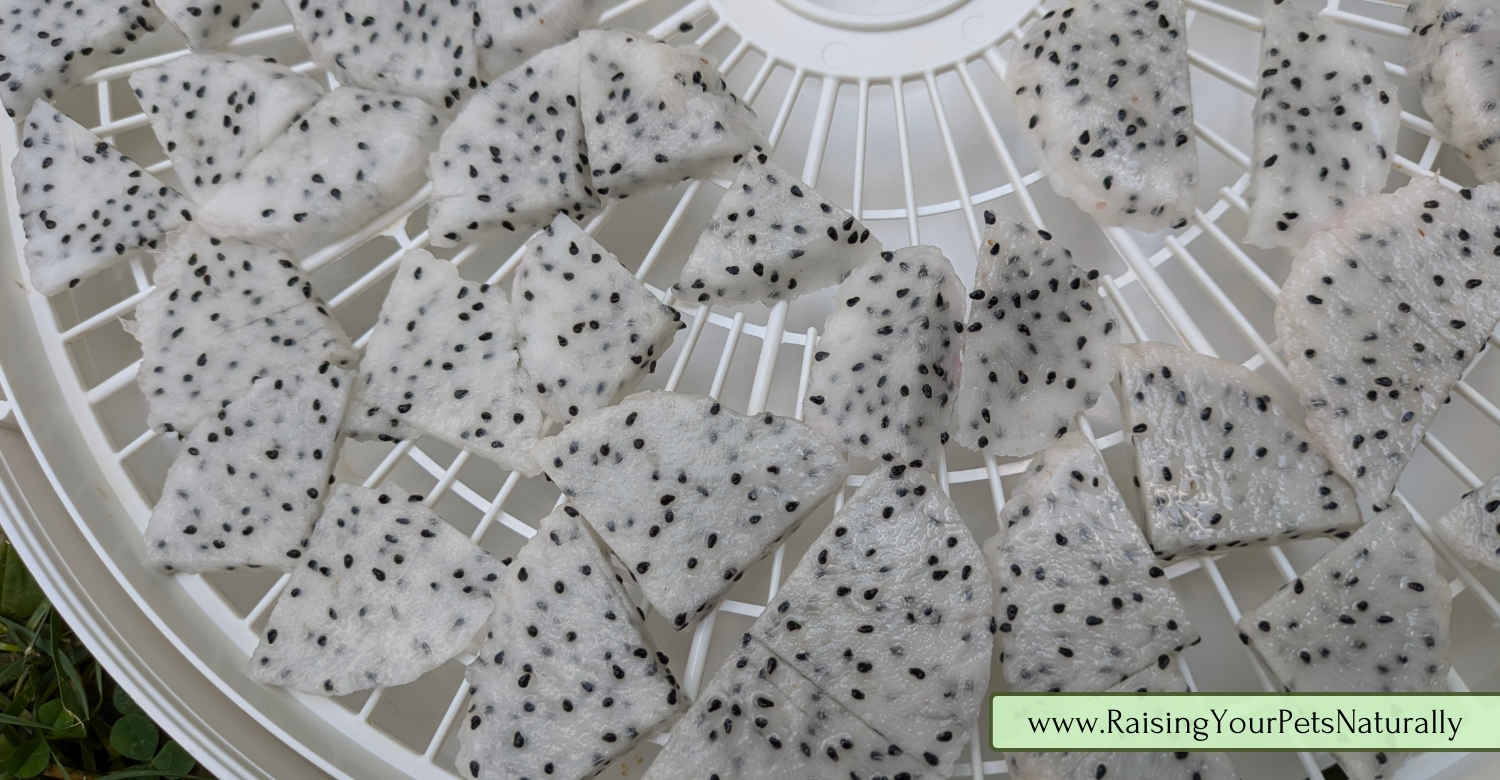Google Adsense—>

What Fruit Can Dogs Eat?

Feeding my senior Cavalier, Dexter, a DIY raw diet has been so beneficial for his overall health. I mean, at almost 15, and with Chiari malformation and syringomyelia, Dexter is still thriving. And I fully believe part of the reason is his fresh and wholesome diet, which includes fruits and veggies. Today, I’m going to go over some of the fruits I like to use in his diet. It’s always fun to dehydrate them so I can use them as healthy dog training treats. If you’ve ever wondered, “Can dogs eat fruit?” or “What fruits can dogs eat?” then this post is for you. Let’s dive into some of Dexter’s favorite fruits and their health benefits, along with how to dehydrate them for a healthy and easy DIY dog treat recipe.
If your dog is diabetic, consult with your veterinarian before introducing any new foods, including fruit, into their diet. While fruits can be enjoyed in moderation, it is important to limit sugar intake, even natural sugars. Dehydrated green vegetables are a healthier alternative for diabetic dogs. Always prioritize your pet’s health and follow professional veterinary advice.
Can Dogs Have Strawberries? Yes!
Health Benefits of Strawberries for Dogs: Strawberries are rich in antioxidants, fiber, and vitamin C, which can help boost your dog’s immune system and aid in digestion.
How to Dehydrate Strawberries for a Healthy Dog Treat: Wash and remove the stem. Slice the strawberries into thin pieces, about 1/8 inch thick. Place them on your dehydrator rack and set it to high. Let them dehydrate for 8-24 hours or until they are completely dry.
Can Dogs Have Bananas? Yes!
Health Benefits of Bananas for Dogs: Bananas are an excellent source of potassium, vitamins, biotin, and fiber. They can help with digestion and promote heart health.
How to Dehydrate Bananas: Slice bananas into thin discs. Place them on the dehydrator rack and set it to high. Dehydrate for 8-24 hours or until they are crispy.
Can Dogs Have Apples? Yes!
Health Benefits of Apples for Dogs: Apples are high in fiber and vitamins A and C. They support skin health and boost the immune system. Remember to remove the seeds and core, as they can be harmful.
How to Dehydrate Apples for Treats: Slice apples thinly. Place the slices on the dehydrator rack and set it to high. Dehydrate for 8-24 hours.
Don’t forget to subscribe to @RaisingYourPetsNaturally for more!
Can Dogs Have Pineapple? Yes!
Health Benefits of Pineapple for Dogs: Pineapple contains bromelain, an enzyme that aids in digestion and reduces inflammation. It’s also high in vitamin C.
How to Dehydrate Pineapples: Remove the core and thick skin of the pineapple. Cut pineapple into small, thin slices. Place the pieces on the dehydrator rack and set it to high. Dehydrate for 10-24 hours.
Can Dogs Eat Blueberries? Yes!
Health Benefits of Blueberries for Dogs: Blueberries are packed with antioxidants, fiber, and vitamins C and K. They support brain health and have anti-inflammatory properties.
How to Dehydrate Blueberries for a snack: Spread blueberries on the dehydrator rack. Set the dehydrator to high. Dehydrate for 8-24 hours.
Can Dogs Eat Blackberries? Yes!
Health Benefits of Blackberries for Dogs: Blackberries are rich in vitamins C and K, fiber, and antioxidants. They help with digestion and promote overall health.
How to Dehydrate Blackberries for dog treats: Cut the blackberries in half. Spread blackberries on the dehydrator rack. Set it to high and dehydrate for 12-24 hours.

Can Dogs Eat Raspberries? Yes!
Health Benefits of Raspberries for Dogs: Raspberries are high in fiber, vitamins, and antioxidants. They support digestive health and reduce inflammation.
How to Dehydrate Raspberries for Snacks: Spread raspberries on the dehydrator rack. Set the dehydrator to high and let them dehydrate for 12-24 hours.
Can Dogs Eat Peaches? Yes!
Health Benefits of Peaches for Dogs: Peaches are high in vitamins A and C, which support skin and immune health. Make sure to remove the pit.
How to Dehydrate Peaches: Slice peaches thinly. Place the slices on the dehydrator rack and set it to high. Dehydrate for 10-24 hours.
Can Dogs Have Nectarines? Yes!
Health Benefits of Nectarines for Dogs: Nectarines are full of antioxidants and vitamins A and C, promoting overall health. Be sure to remove the pit.
How to Dehydrate Nectarines: Slice nectarines thinly. Place the slices on the dehydrator rack and set it to high. Dehydrate for 10-24 hours.
Can Dogs Eat Dragon Fruit? Yes!
Health Benefits of Dragon Fruit for Dogs: Dragon fruit is rich in vitamins C and B, fiber, and antioxidants. It boosts the immune system, aids digestion, and supports overall health.
How to Dehydrate Dragon Fruit: Cut the dragon fruit in half and peel away the skin. Slice the dragon fruit into discs about 1/8 inch thick. Place the slices on the dehydrator rack and then cut into quarters. Set to high and dehydrate for 24 hours.

How to Store Dehydrated Fruits for Your Dog
To ensure the freshness of your dehydrated fruits, proper storage is important. Here are some tips:
- Freezer Storage: Store your dehydrated fruits in an airtight container or freezer bag and keep them in the freezer. This helps preserve their nutrients and keeps them fresh for longer.
- Daily Portions: When you’re ready to use them, pull out a few days’ worth of treats and keep them in a smaller container at room temperature or in the refrigerator. I usually place a couple of days’ worth of treats into Dexter’s treat jar. This way, they are always ready for training sessions or quick snacks.

FAQs About Dogs and Fruit
- Can dogs eat fruit with seeds? Some fruits, like apples and peaches, have seeds or pits that should be removed as they can be harmful. Others, such as dragon fruit and kiwi, are safe to eat.
- When can dogs eat fruit? Fruits can be given as treats or mixed into meals, but always introduce them gradually. When introducing fruit or new foods to your dog, start with a couple of treats and see how they tolerate the fruit.
- What age can dogs eat fruit? Puppies can start eating fruit once they are on solid food, but always consult your puppy’s holistic vet for specific recommendations.
- Can dogs eat fruit daily? Yes, but moderation is key. Fruits should be a part of a balanced diet.
- Can dogs eat fruit peels? It’s best to remove peels, especially if they are thick or tough, as they can be hard for dogs to digest.
- Can dogs eat fruit puree? Yes, DIY fruit purees are great for meal toppers! Instead of dehydrating, pop them into a blender then pour into silicone molds for a health topper. If you are looking to buy a prepared fruit puree, as with all foods, read the ingredient panel. You would want to make sure all the ingredients are dog-safe fruits and nothing else.
- Can dogs eat fruit pits? No. Fruit pits can be dangerous and should always be removed.
- Can dogs eat fruit skin? Some fruit skins, like apples and peaches, are actually healthy, as long as they are small enough and don’t pose a choking hazard.
I hope you found this guide to dogs and fruit helpful! Dehydrating fruits is a great way to make healthy, natural snacks for your dog.
Feel free to share in the comments below your dehydrating tips or other favorite fruits you like to use.
Are you looking for even more ways to stay up to date with Raising Your Pets Naturally? Sign up for the newsletter for more tips and promotions. Don’t forget to be social and Like, Follow and Subscribe.
Facebook Twitter Pinterest Instagram YouTube
 |

Check out our treat book! |

Google Adsense—>




